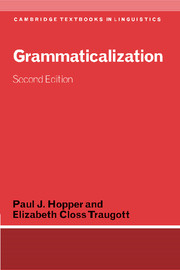Book contents
- Frontmatter
- Contents
- List of figures
- List of tables
- Preface and acknowledgments
- List of abbreviations
- 1 Some preliminaries
- 2 The history of grammaticalization
- 3 Mechanisms: reanalysis and analogy
- 4 Pragmatic factors
- 5 The hypothesis of unidirectionality
- 6 Clause-internal morphological changes
- 7 Grammaticalization across clauses
- 8 Grammaticalization in situations of extreme language contact
- 9 Summary and suggestions for further work
- Notes
- References
- Index of names
- Index of languages
- General index
7 - Grammaticalization across clauses
Published online by Cambridge University Press: 05 June 2012
- Frontmatter
- Contents
- List of figures
- List of tables
- Preface and acknowledgments
- List of abbreviations
- 1 Some preliminaries
- 2 The history of grammaticalization
- 3 Mechanisms: reanalysis and analogy
- 4 Pragmatic factors
- 5 The hypothesis of unidirectionality
- 6 Clause-internal morphological changes
- 7 Grammaticalization across clauses
- 8 Grammaticalization in situations of extreme language contact
- 9 Summary and suggestions for further work
- Notes
- References
- Index of names
- Index of languages
- General index
Summary
Introduction
Ordinary discourse does not consist of isolated, context-free utterances, but of linked discourse units comprising reports, orders, comments, descriptions, and other kinds of linguistic activity. These units, usually expressed by clauses, typically consist of a verb and indicators of the arguments of the verb, in the form of lexical nouns, pronouns, or pronominal affixes. All languages have devices for linking clauses together into what are called complex sentences. These tend to be classified in grammars according to functional—semantic principles, for example, whether a clause functions as an NP (complements, or “noun clauses,” that are arguments of the clause), modifies an NP (relative clauses), or has adverbial functions (e.g., temporal, causative, or conditional clauses). However, the form of a “complex sentence” may differ quite radically among languages and among speakers and occasions of speech in one and the same language, from fairly simple juxtapositions of relatively independent clauses characteristic of casual speech, such as (1), to complex dependent rhetorical constructions typically arising in the context of traditions of written grammar, such as (2):
(1) Within the decade there will be an earthquake. It is likely to destroy the whole town.
(2) That there will be an earthquake within the decade that will destroy the whole town is likely.
It has been customary to discuss the development of markers of clause linkage such as the two instances of that in (2) in terms of grammaticalization.
- Type
- Chapter
- Information
- Grammaticalization , pp. 175 - 211Publisher: Cambridge University PressPrint publication year: 2003

